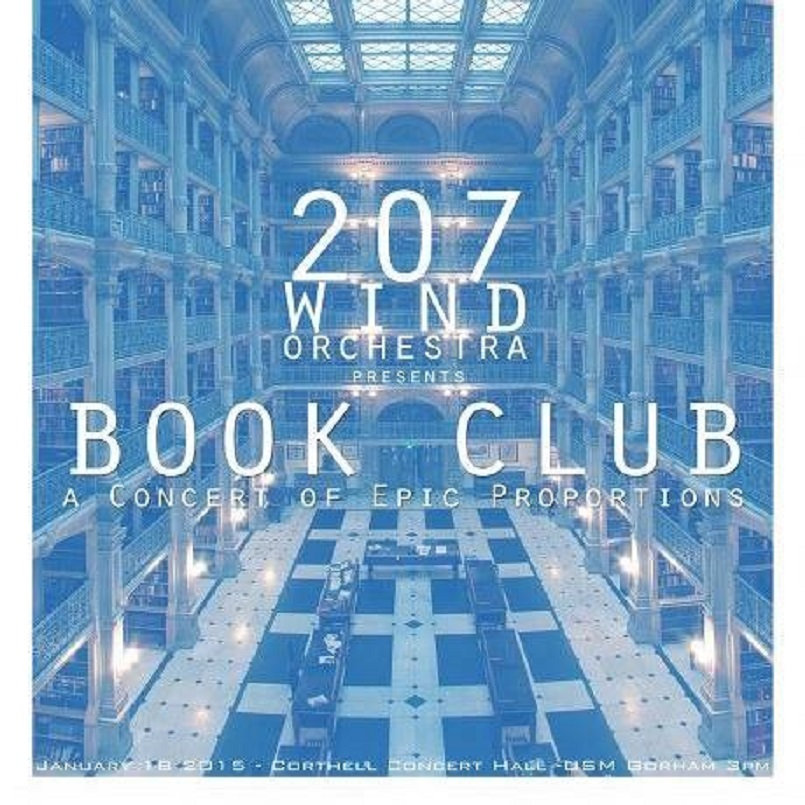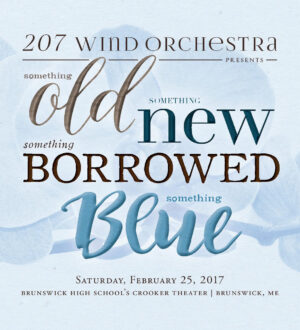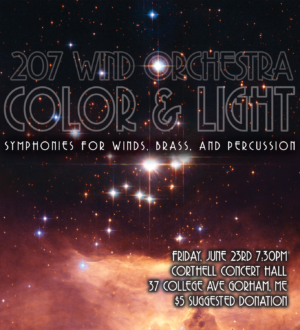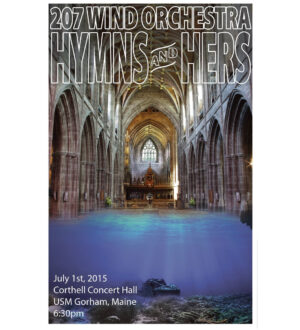Description
Recorded live on January 18, 2015 Corthell Concert Hall, University of Southern Maine Timothy Burns, conductor Jimmy Dority, recording engineer Dave Surkin, cover art Resonances I, Ron Nelson (b. 1929) Symphony No. 1 - "The Lord of the Rings", Johan de Meij (b. 1953) Gandalf (The Wizard) Lothlórien (The Elvenwood) Gollum (Sméagol) Journey in the Dark a. The Mines of Moria b. The Bridge of Khazad-Dûm Hobbits Prelude: Treasure Island, Josh Newton The Cask of Amontillado, Timothy Burns Of Sailors and Whales, W. Francis McBeth Ishmael Queequeg Ahab The White Whale Flute/Piccolo Karina Babcock Diana McNulty Nicole J. Rawding Eb Clarinet Nina Oatley Walsh Clarinet Tegan Bryand Julie Cross Jordan Dube Ray Libby Ellen Rust Nina Oatley Walsh Alto Clarinet Ellen Lucy Bass Clarinet Libbie Bowder Ellen Lucy Contrabass Clarinet Tegan Bryand Oboe Billie Jo Brito Jonathan Tefft English Horn Billie Jo Brito Bassoon Katie Hendrick Linda Soares Contrabassoon Ryan Blanchard Soprano Saxophone Sean Potter Alto Saxophone Jason LaWind Sean Potter Tenor Saxophone Loren Peters Baritone Saxophone Michael Sullivan Trumpet Alan Kaschub Thomas Kremser Ross Miller Catriona Shepherd Horn Carolyn Kanicki Yvonne Mummé Connie Plaisted Paul Thomas Trombone Tim Bathras Matt Cloutier Tom Michaud Eric Quinn Euphonium Tim Clement Adam Goad Tuba Joshua LaChance String Bass Kinnon Church Piano David Delano Percussion Jeffrey Coggins David Delano Jacob Forbes Nathaniel Gowen Robert Neeb Jenna Nelson
Resonances I is a study in contemporary compositional and performance techniques. The six parts of this piece are made up of boxes of activity (the duration of which is solely determined by the conductor), each with various note combinations, aleatoric activities, or techniques employed. As the title implies, the work explores textures, sounds, and the atmosphere, thus . . . resonances.
A native of Joliet, Illinois, Ron Nelson was born December 14, 1929. He received his bachelor of music degree in 1952, the master’s degree in 1953, and the doctor of musical arts degree in 1957, all from the Eastman School of Music at the University of Rochester. He studied in France at the Ecole Normale de Musique and at the Paris Conservatory under a Fulbright Grant in 1955. Dr. Nelson joined the Brown University faculty the following year, and taught there until his retirement in 1993.
Johan de Meij’s first symphony The Lord of the Rings is based on the trilogy of that name by J.R.R. Tolkien. This book has fascinated many millions of readers since its publication in 1955. The symphony consists of five separate movements, each illustrating a personage or an important episode from the book.
The movements are:
I. GANDALF (The Wizard)
II. LOTHLÓRIEN (The Elvenwood)
III. GOLLUM (Sméagol)
IV. JOURNEY IN THE DARK a. The Mines of Moria b. The Bridge of Khazad-Dûm
V. HOBBITS
The symphony was written in the period between March 1984 and December 1987, and had its première in Brussels on 15th March 1988, performed by the “Groot Harmonieorkest van de Gidsen” under the baton of Norbert Nozy. In 1989, The Symphony The Lord of the Rings was awarded a first prize in the Sudler International Wind Band Composition Competition in Chicago, and a year later, the symphony was awarded by the Dutch Composers Fund. In 2001, the orchestral version was premiered by the Rotterdam Philharmonic Orchestra and recorded by the London Symphony Orchestra.
Although it is not simple to summarize such an extensive and complex work, the main outline is as follows: the central theme is the Ring, made by primeval forces that decide the safety or destruction of the World. For years it was the possession of the creature Gollum, but when the Ring falls into the hands of the Hobbits the evil forces awake and the struggle for the Ring commences. There is but one solution to save the World from disaster: the Ring must be destroyed by the fire in which it was forged: Mount Doom in the heart of Mordor, the country of the evil Lord Sauron.
It is the Hobbit Frodo who is assigned to carry out this task, and to assist him a company, the Fellowship of the Ring, is formed under the leadership of Gandalf, the wizard, which includes the Hobbits Sam, Peregrin and Merin, the Dwarf Gimli, the Elf Legolas, Boromir and Aragorn, the later King. The Companions are secretly followed by Gollum, who does not shun any means, however perfidious, to recover his priceless Ring. However, the Companions soon fall apart, after many pernicious adventures and a surprising dénouement Frodo and Sam can at last return to their familiar home, The Shire.
Explanation of the five movements:
GANDALF (The Wizard) The first movement is a musical portrait of the wizard Gandalf, one of the principal characters of the trilogy. His wise and noble personality is expressed by a stately motiff which is used in a different form in movements IV and V. The sudden opening of the Allegro vivace is indicative of the unpredictability of the grey wizard, followed by a wild ride on his beautiful horse Shadowfax.
LOTHLÓRIEN (The Elvenwood) The second movement is an impression of Lothlórien, the elvenwood with its beautiful trees, plants, exotic birds, expressed through woodwind solo’s. The meeting of the Hobbit Frodo with the Lady Galadriel is embodied in a charming Allegretto; in the Mirror of Galadriel, a silver basin in the wood, Frodo glimpses three visions, the last of which, a large ominous Eye, greatly upsets him.
GOLLUM (Sméagol) The third movement describes the monstrous creature Gollum, a slimy, shy being represented by the soprano saxophone. It mumbles and talks to itself, hisses and lisps, whines and snickers, is alternately pitiful and malicious, is continually fleeing and looking for his cherished treasure, the Ring.
JOURNEY IN THE DARK The fourth movement describes the laborious journey of the Fellowship of the Ring, headed by the wizard Gandalf, through the dark tunnels of the Mines of Moria. The slow walking cadenza and the fear are clearly audible in the monotonous rhythm of the low brass, piano and percussion. After a wild pursuit by hostile creatures, the Orks, Gandalf is engaged in battle with a horrible monster, the Balrog, and crashes from the subterranean bridge of Khazad-Dûm in a fathomless abyss. To the melancholy tones of a Marcia Funèbre, the bewildered Companions trudge on, looking for the only way out of the Mines, the East Gate of Moria.
HOBBITS The fifth movement expresses the carefree and optimistic character of the Hobbits in a happy folk dance; the hymn that follows emanates the determination and noblesse of the hobbit folk. The symphony does not end on an exuberant note, but is concluded peacefully and resigned, in keeping with the symbolic mood of the last chapter “The Grey Havens” in which Frodo and Gandalf sail away in a white ship and disappear slowly beyond the horizon.
Johan de Meij studied trombone and conducting at the Royal Conservatory of Music in The Hague. He has earned international fame as a composer and arranger. His catalogue consists of original compositions, symphonic transcriptions and arrangements of film scores and musicals. His Symphony No. 1, The Lord of the Rings, based on Tolkien’s best-selling novels of the same name, was his first composition for wind orchestra. It received the prestigious Sudler Composition Award in 1989. In 2001, the orchestral version was premiered by the Rotterdam Philharmonic Orchestra.
The Lord of the Rings has been recorded by renowned orchestras such as the London Symphony Orchestra, the North Netherlands Orchestra, the Nagoya Philharmonic Orchestra and the Amsterdam Wind Orchestra. His cello concerto Casanova was awarded First Prize at the International Composition Competition of Corciano [Italy] in 1999. A year later, de Meij won the Oman International Composition Prize with The Red Tower. His Symphony No. 3, Planet Earth was awarded 2nd Prize in the 2006 edition of the Corciano Competition. He received the Dutch Wind Music Award 2007 for his important role in the worldwide advancement of the genre.
Besides composing and arranging, Johan de Meij is active as a performer, conductor, adjudicator and lecturer. As a trombone and euphonium player, he has performed with the major orchestras and ensembles in The Netherlands, such as the Netherlands Wind Ensemble, the Dutch Brass Sextet, the Radio Chamber Orchestra, the Amsterdam Wind Orchestra and Orkest ‘De Volharding’. He has conducted some of the leading wind orchestras of Europe, Asia, North and South America and has led master classes around the world. In 2010, he was appointed principal guest conductor of the renowned Simón Bolívar Youth Wind Orchestra from Caracas, Venezuela. In 2014, Johan de Meij became principal guest conductor of both The New York Wind Symphony and The Kyushu Wind Orchestra in Fukuoka, Japan.
Prelude: Treasure Island was originally written as a collaborative project with other artists. Each week, we were given a particular challenge; in this case it was to design a book cover. “Prelude: Treasure Island” is an attempt to capture the gritty nature of the pirate tale, the openness of the sea and a prevailing sense of adventure. This is an expanded and reorchestrated version of the original piece.
Josh Newton is a composer, performer, teacher and lecturer from Farmingdale, ME. He earned his Master’s Degree in Composition from the University of Southern Maine in 2013, studying with Daniel Sonenberg. Performances of his work have been given by the Portland Symphony Orchestra, the Ethel String Quartet and the Da Capo Chamber Players. He has been featured at the Portland Chamber Music Festival, the Back Cove Contemporary Music Festival, New Music at Frontiers, Frantasia Fest and the Aspen Composers Conference. With a diverse academic background, he has presented papers on Beethoven, Debussy, Monty Python, Tolkien, and Henryk Górecki. His instrumental works display a deep admiration for the romantic tradition, and his vocal works include settings of texts by Rumi, Paul Celan, Liu Xiaobao, Anna Akhmatova, Hilda Doolittle, French fairy tales, and religious texts. He lives with his wife and son, a gaggle of cats and a puppy near a beautiful stream and a lousy driveway and writes about composition and music at http://www.newtonmusic.com/blog.
The Cask of Amontillado is a tone poem for Concert Band based on the short story by Edgar Allen Poe. The narrator, Montresor, opens the story by stating “The thousand injuries of Fortunato I had borne as I best could, but when he ventured upon insult, I vowed revenge.” Montressor lures Fortunato, who is dressed as a jester including a cone hat with bells attached, to his home telling him that he has a wine, an Amontillado, but isn’t sure it’s the real thing. As dusk falls, they leave the carnival and approach the Montressor villa, a horn sounds. They enter the wine cellars and the nitre in the walls of the tunnels makes Fortunato’s breathing hard and he goes into a coughing fit. As they walk through the tunnels on the way to where the Amontillo is kept they talk of the Masons and Montressor says “Yes, I am of the masons” and pulls out a trowel from his cloak. Finally they reach the end of the tunnel and there is nothing but some shackles hung from a dead end. Montressor uses Fortunato’s drunkenness to his advantage and quickly chains him up. Montressor begins to build a wall around Fortunato. As the wall gets higher, Fortunato sobers up and realizes he’s in trouble. He tries to joke and says “We will all have a good laugh about this later!”, but as Montressor keeps building the wall he cries out “For the love of God, Montressor!”, and coldly Montressor replies, “Yes, for the love of God.”. As the last few bricks are put in place Fortunato’s coughing fits grow so severe he passes out. Montressor calls “Fortunato…..Fortunato…..”, and when there is no answer he thrusts his torch in the small hole remaining and just sees the hat of the jester fall off the now dead Fortunato’s head. The story closes saying “I forced the last stone into its position; I plastered it up. Against the new masonry I reerected the old rampart of bones. For the half of a century no mortal has disturbed them. ‘In pace requiescat!'”
Maine-based composer and conductor Timothy Burns has been actively composing music since he was 9. His works are frequently performed throughout northern New England by ensembles such as the Southern Maine Symphony Orchestra, Casco Bay Wind Symphony, and the University of Southern Maine Wind Ensemble. In 2009 Tim placed third in the Walter Beeler Memorial Composition with The Cask of Amontillado, and relieved an honorable mention it the Craig and Janet Swan Composer Prize for his orchestral tone poem Of Rocks. Recently, the Da Capo Chamber Players played his piece Night Visions, and his string quartet (and so to dark) was performed by ETHEL.
As a conductor, Tim is often seen with the Casco Bay Wind Symphony, the Portland Youth Ensembles, and in his car where he leads the world’s greatest orchestra while waiting at stop lights. In 2015, Tim founded the 207 Wind Orchestra, a group dedicated to playing the highest quality literature written for winds, where he serves as music director.
As a performer, Tim is an active horn player and percussionist. Recently he’s begun to study theremin and has always enjoyed playing the recorder. Tim holds degrees in music education (BA) and composition (MM) from the University of Southern Maine. His primary teachers have been Dr. Daniel Sonenberg and Dr. Peter Martin.
Tim currently lives in Old Orchard Beach, Maine where he enjoys playing Skyrim and watching Survivor with his cat Percy.
Of Sailors and Whales is a five-movement work based on five scenes from Herman Melville’s Moby Dick. It was commissioned by and is dedicated to the California Band Directors Association, Inc., and was premiered in February 1990 by the California All-State Band, conducted by the composer. The work is subdedicated to Robert Lanon White, Commander USN (Ret.), who went to sea as a simple sailor.
Ishmael – “I go to sea as a simple sailor”
Queequeg – “It was quite plain that he must be some abominable savage, but Queequeg was a creature in the transitory state – neither caterpillar nor butterfly.”
Ahab – “So powerfully did the whole grim aspect of Ahab affect me that for the first few moments I hardly noted the barbaric white leg upon which he partly stood.”
The White Whale – “Moby Dick seemed combinedly possessed by all the angels that fell from heaven. The birds! – the birds! They mark the spot.”
William Francis McBeth was a prolific American composer, whose wind band works are highly respected. His primary musical influences included Clifton Williams, Bernard Rogers, and Howard Hanson. The popularity of his works in the United States during the last half of the twentieth century led to many invitations and appearances as a guest conductor, where he often conducted the premiere performances of some of his compositions, the majority of which were commissioned. His conducting activities have taken him to forty-eight states, three Canadian provinces, Japan, and Australia. At one time, his “Double Pyramid Balance System” was a widely used pedagogical tool in the concert band world.
From 1957 until his retirement in 1996, McBeth taught at Ouachita Baptist University in Arkadelphia, Arkansas.





Reviews
There are no reviews yet.